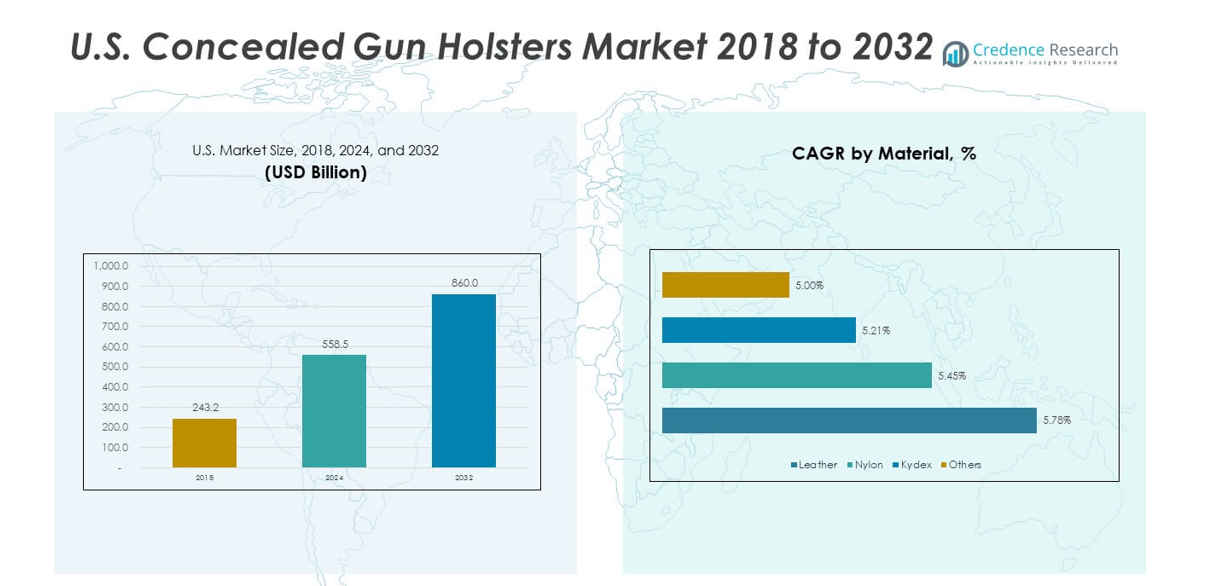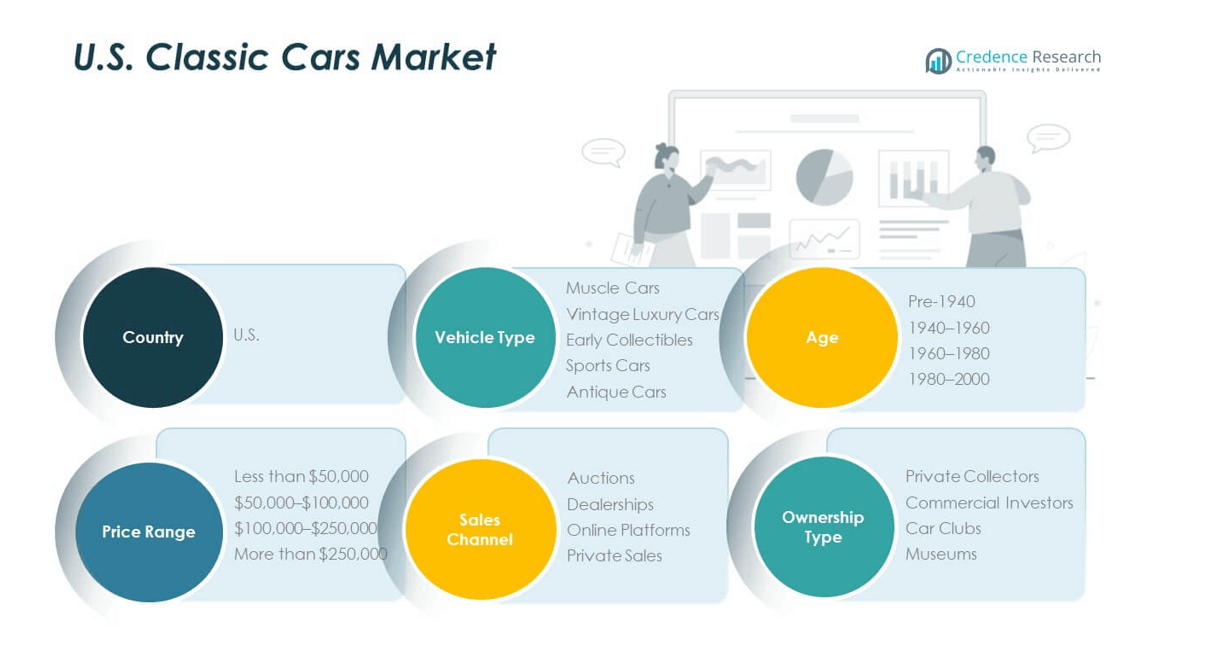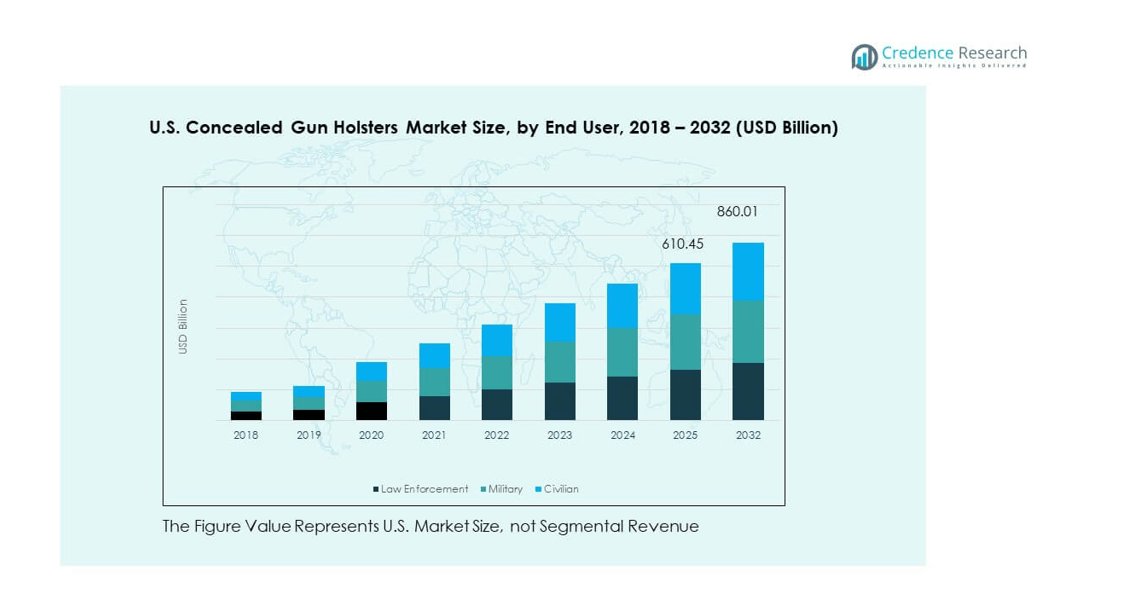Market Overview:
The U.S. Concealed Gun Holsters Market size was valued at USD 39.41 billion in 2018, grew to USD 50.79 billion in 2024 and is anticipated to reach USD 75.48 billion by 2032, at a CAGR of 5.02 % during the forecast period.
| REPORT ATTRIBUTE |
DETAILS |
| Historical Period |
2020-2023 |
| Base Year |
2024 |
| Forecast Period |
2025-2032 |
| U.S. Concealed Gun Holsters Market Size 2024 |
USD 50.79 billion |
| U.S. Concealed Gun Holsters Market, CAGR |
5.02% |
| U.S. Concealed Gun Holsters Market Size 2032 |
USD 75.48 billion |
The market is driven by rising demand for personal safety and increased conceal‑carry licences, prompting individuals to invest in reliable holsters. Manufacturers are responding with innovations in materials and ergonomics to meet the needs of everyday carry users. The shift toward online retail and broader availability has made concealed‑carry holsters more accessible and popular among civilians seeking discreet carry solutions.
Regionally within the United States, states with the most permissive carry laws lead the market, while emerging pockets in suburban and rural regions show faster growth rates. The Southeast and Mountain West regions, where permitless‑carry laws and firearm ownership are higher, show strong uptake of concealed‑carry holsters. Conversely, stricter‑regulation states serve as smaller markets, but upcoming legislative changes in some of these areas could unlock additional potential.

Market Insights:
- The U.S. Concealed Gun Holsters Market size was valued at USD 39.41 million in 2018, reached USD 50.79 million in 2024, and is projected to hit USD 75.48 million by 2032, growing at a CAGR of 5.02% during the forecast period.
- North America leads the market with 55% share due to high firearm ownership and permissive concealed carry laws. The Southeast region contributes 25% supported by outdoor gun culture and lenient state regulations, while the Mountain-West accounts for 20% driven by strong hunting and tactical firearm usage.
- The Southeast and Mountain-West states are the fastest-growing regions, with increasing permitless carry adoption and rising civilian interest in personal safety driving demand.
- By end-user segment, civilians dominate the market with approximately 60% share, followed by law enforcement at 25% and military at 15%, reflecting broader adoption among private gun owners.
- By product type, Inside the Waistband (IWB) holsters hold the largest share at 45%, followed by Outside the Waistband (OWB) at 30%, showing preference for discreet and everyday carry solutions.
Access crucial information at unmatched prices!
Request your sample report today & start making informed decisions powered by Credence Research Inc.!
Download Sample
Market Drivers:
Increasing Focus on Personal Safety
The rising concern for personal safety among civilians is a key driver for the U.S. Concealed Gun Holsters Market. Individuals are increasingly seeking ways to protect themselves, particularly in areas with higher crime rates. This growing demand for concealed carry solutions leads to an increase in holster adoption across various demographics. As more states relax concealed carry regulations, more individuals are opting for firearms for self-defense, which drives the need for reliable and ergonomic holsters.
- For instance, Smith & Wesson, a leading firearms manufacturer, has seen an uptick in sales for concealed carry firearms, prompting a similar rise in demand for holsters that support safe and comfortable carrying. This growing demand for concealed carry solutions leads to an increase in holster adoption across various demographics.
Rising Concealed Carry Permits
The U.S. has witnessed a steady increase in concealed carry permits, further boosting the demand for concealed gun holsters. In particular, states with lenient gun laws have seen a rapid rise in permit issuances. As more individuals obtain permits to carry concealed firearms, the demand for holsters that offer comfort and security continues to grow. Holster manufacturers have responded by offering a diverse range of products tailored to various user preferences, from everyday carry to tactical use.
- For instance, in 2023, the state of Ohio issued only 15,581 new concealed handgun licenses, a significant drop following the state’s 2022 law that made permits optional for concealed carry. This reflects the broader, ongoing national conversation about firearm access and ownership, rather than a clear nationwide trend of increasing permit issuances.
Technological Advancements in Holster Design
Innovations in materials and design are playing a significant role in driving the U.S. Concealed Gun Holsters Market. Manufacturers are utilizing advanced materials such as Kydex and leather composites, which provide improved durability, retention, and comfort. The evolution of designs with adjustable retention systems, sweat guards, and ergonomic features addresses the practical needs of concealed carriers. These technological advancements ensure that holsters remain functional, discreet, and comfortable for daily use.
Growth of E-Commerce Platforms
The U.S. Concealed Gun Holsters Market has experienced significant growth through online sales platforms. The convenience of purchasing gun holsters online and the ability to compare features and prices have made it easier for consumers to find the best fit for their needs. E-commerce platforms also provide access to a broader range of holster brands and designs. This growing trend in online shopping has expanded the market by reaching more customers, including those in rural areas with limited access to physical stores.
Market Trends:
Customization and Personalization of Holsters
There is an increasing demand for customizable and personalized concealed gun holsters. Consumers are looking for holsters that not only fit their specific firearm models but also reflect their style and preferences. Holster manufacturers are responding to this trend by offering a variety of customizable options, including adjustable clips, color choices, and different carry positions. This trend is expected to continue as more people seek products that cater to their unique requirements for both comfort and functionality.
- For example, through its Custom Shop, Galco Gunleather offers holsters made from exotic skins like alligator, shark, and ostrich, catering to customers who want to reflect their unique style. Consumers are looking for holsters that not only fit their specific firearm models but also reflect their style and preferences.
Integration of Smart Technology in Holsters
A growing trend within the U.S. Concealed Gun Holsters Market is the integration of smart technology. Some manufacturers are incorporating features such as biometric locks and GPS tracking to provide users with added security and convenience. These high-tech holsters offer advanced functionalities like automatic locking and unlocking, enhancing the overall safety of concealed carry. The use of such technologies is attracting tech-savvy consumers who value innovation and security in their holsters.
Expansion of Women’s Concealed Carry Products
As more women embrace concealed carry, manufacturers are expanding their product offerings to cater to female consumers. Holsters designed specifically for women address factors such as body shape, clothing styles, and comfort. Female-targeted holsters are increasingly seen in a variety of designs, including ankle holsters, belly bands, and corset-style holsters. This trend is contributing to a growing segment of the market that emphasizes both style and functionality for female gun owners.
Focus on Concealment and Comfort
The U.S. Concealed Gun Holsters Market is seeing a significant trend towards holsters that prioritize comfort and concealment. Many consumers are opting for holsters that provide maximum concealment while ensuring comfort for long hours of wear. This trend has led to innovations in materials like memory foam and breathable fabrics that enhance comfort without compromising on retention and security. Holsters that offer a smooth, discreet fit are becoming increasingly popular among everyday carriers who prioritize comfort alongside functionality.

Market Challenges Analysis:
Strict Regulatory Environment
One of the key challenges for the U.S. Concealed Gun Holsters Market is the complex and evolving regulatory environment surrounding concealed carry laws. States vary in their requirements for obtaining concealed carry permits, and changes in legislation can significantly impact the demand for holsters. Some regions impose stricter rules regarding the carrying and storage of firearms, which may affect consumer behavior. The market must adapt to these legal fluctuations, requiring manufacturers to stay updated with local regulations and ensure compliance with ever-changing rules.
Consumer Concerns Regarding Holster Quality and Safety
Consumers often face challenges in selecting holsters that meet both their quality and safety expectations. Concerns over holster durability, retention, and the safety of concealed carry can make buyers hesitant. Manufacturers are continuously working to address these issues by offering more rigorous testing and providing clear product guarantees. However, ensuring that each holster meets stringent quality standards remains a challenge. This market requires continuous improvement in manufacturing processes and quality assurance to gain consumer trust.
Market Opportunities:
Rising Interest in Concealed Carry Among Urban Populations
The U.S. Concealed Gun Holsters Market is witnessing increasing demand from urban areas, where concerns about personal safety and security are high. Urban populations, particularly in larger cities, are seeking concealed carry solutions due to rising crime rates and security threats. This growing interest provides an opportunity for holster manufacturers to expand their presence in urban markets. As more people seek reliable and discreet ways to carry firearms, the demand for high-quality concealed gun holsters will continue to rise.
Emerging Demand from International Markets
There is significant potential for growth in international markets, as the concept of concealed carry begins to gain traction in other parts of the world. While the U.S. remains the largest market, countries with increasing firearm ownership and self-defense concerns are showing interest in concealed carry products. Manufacturers can capitalize on this by expanding their distribution networks and marketing efforts globally. The global appeal of concealed gun holsters presents an exciting opportunity for further market expansion beyond the U.S. borders.
Market Segmentation Analysis:
By Product
The U.S. Concealed Gun Holsters Market is segmented into various types of holsters based on carry position. Inside the Waistband (IWB) holsters dominate due to their compact and discreet design, making them ideal for everyday carry. Outside the Waistband (OWB) holsters are preferred for open carry or in situations where quick access is necessary. Shoulder holsters are gaining popularity for tactical or off-duty use, while ankle holsters are favored for backup weapons. Other holster types, such as belly bands and thigh rigs, cater to niche needs.
- For example, the Alien Gear Cloak Tuck IWB holster is a popular choice among users for its comfort and concealability. Outside the Waistband (OWB) holsters are preferred for open carry or in situations where quick access is necessary, such as for law enforcement or tactical professionals.
By Material
Materials used in holster manufacturing significantly influence consumer choices. Leather holsters are known for their comfort, durability, and traditional appeal, making them a popular choice. Nylon and Kydex holsters offer a more modern and functional design, with Kydex being particularly favored for its rigid form and retention properties. Other materials include hybrid options that combine leather and synthetic materials for enhanced performance.
- For instance, Bianchi’s leather holsters have been favored by users for their craftsmanship and longevity. Nylon and Kydex holsters offer a more modern and functional design, with Kydex being particularly favored for its rigid form and retention properties.
By Distribution Channel
The U.S. Concealed Gun Holsters Market benefits from diverse distribution channels. Online stores are the fastest-growing segment, offering convenience and a wide range of choices. Specialty stores provide expert advice and quality products for customers, while supermarkets and hypermarkets reach a broader audience with convenient access. Direct buyers, including law enforcement and military organizations, often make bulk purchases through direct sales.
By End User
End users in the U.S. Concealed Gun Holsters Market include law enforcement, military, and civilian sectors. Law enforcement and military segments require high-performance holsters for duty and tactical use. Civilian users dominate the concealed carry market, driven by increased interest in personal safety and self-defense.

Segmentation:
By Product
- Inside the Waistband
- Outside the Waistband
- Shoulder Holsters
- Ankle Holsters
- Others
By Material
- Leather
- Nylon
- Kydex
- Others
By Distribution Channel
- Online Stores
- Specialty Stores
- Supermarkets/Hypermarkets
- Direct Buyers
By End User
- Law Enforcement
- Military
- Civilian
Regional Analysis:
North America Region Analysis
The U.S. Concealed Gun Holsters Market maintains its strongest footprint in North America, where the United States drives the majority of demand. It commands roughly 55 % of the regional market share, driven by high firearm ownership and permissive concealed‑carry laws. The presence of leading manufacturers and a mature retail and online system reinforce its dominance. Markets in states with newer permit‑free carry laws are expanding fastest. The consumer base spans civilian, law‑enforcement, and military users, contributing stability. It remains the focal region for launch of new materials and styles.
Emerging Growth in Southeast and Mountain‑West States
Within the United States, growth concentrates in the Southeast and Mountain‑West states, where carry‑permit laws relax and outdoor gun culture thrives. In these regions, the U.S. Concealed Gun Holsters Market has captured an estimated 25 % of incremental volume growth recently. Retailers report a rising interest in concealed‑carry among first‑time buyers and returning permit holders. Manufacturers tailor designs to climate, carry style and clothing preferences in these zones. Local gun‑show circuits and online niche platforms fuel awareness and uptake. Direct‑to‑consumer shipping supports remote states. The trend gives players in the market a clear geographic focus for expansion.
Other U.S. Regions and Growth Potential
Other U.S. regions, including the Northeast and parts of the Midwest and West Coast, currently contribute around 20 % of the market share for concealed‑carry holsters. These areas have stricter carry regulations and lower general firearm ownership rates, which limits immediate market size. Nonetheless, potential exists when legislative shifts or consumer attitudes change. Brands that offer discreet carry solutions and tailor to urban users see room for growth in these markets. The U.S. Concealed Gun Holsters Market can benefit from outreach to suburban pockets and female carrier segments in these regions. The region’s slower pace presents a strategic opportunity for long‑term investment.
Shape Your Report to Specific Countries or Regions & Enjoy 30% Off!
Key Player Analysis:
Competitive Analysis:
The U.S. Concealed Gun Holsters Market is characterized by a diverse range of manufacturers offering products tailored to various user needs. Key players like Safariland, Galco Gunleather, and Alien Gear Holsters lead the market, maintaining competitive positions through constant product innovation and strategic partnerships. These companies emphasize comfort, durability, and concealability, which are crucial in meeting consumer demands. The market also features smaller, niche players who focus on specific holster types or materials, gaining traction through specialized offerings. Intense competition exists in both the civilian and law enforcement sectors, as manufacturers strive to address evolving consumer preferences and regulatory changes.
Recent Developments:
- In October 2025, The Blackhawk Group entered into a strategic partnership with Hartzell Propeller. This collaboration brings advanced propeller solutions to a wider range of aircraft platforms and expands Blackhawk’s service offerings in the performance upgrade market. The partnership aims to deliver premium support and operational readiness for clients in the aviation sector.
- In March 2025, Galco International LLC completed the acquisition of Brozelco, Inc., a Tennessee-based leader in industrial automation solutions. This acquisition allows Galco to expand its expertise in custom control solutions, turnkey electrical projects, and hazardous location-certified systems integration, enhancing its offerings for customers in multiple industries.
Report Coverage:
The research report offers an in-depth analysis based on product segments, materials, distribution channels, and end-users. It details leading market players, providing an overview of their business, product offerings, investments, revenue streams, and key applications. Additionally, the report includes insights into the competitive environment, SWOT analysis, current market trends, as well as the primary drivers and constraints. Furthermore, it discusses various factors that have driven market expansion in recent years. The report also explores market dynamics, regulatory scenarios, and technological advancements that are shaping the industry. It assesses the impact of external factors and global economic changes on market growth. Lastly, it provides strategic recommendations for new entrants and established companies to navigate the complexities of the market.
Future Outlook:
- The U.S. Concealed Gun Holsters Market is expected to see continued growth driven by consumer demand for concealed carry solutions.
- Technological advancements will lead to innovations in holster design, offering enhanced comfort, concealability, and retention features.
- Manufacturers will increasingly focus on customization options, catering to a broader range of consumer preferences.
- E-commerce will continue to dominate as the primary distribution channel, increasing accessibility for consumers nationwide.
- Regional expansions, particularly in suburban and rural areas, will provide new market opportunities.
- The shift toward hybrid materials in holster manufacturing will drive product diversification.
- Law enforcement and military markets will maintain steady demand due to tactical needs.
- The emergence of smart technology in holsters, such as biometric locking systems, will enhance security features.
- Regulatory changes in concealed carry laws will create new avenues for market growth.
- Market consolidation may occur as larger players acquire smaller, niche manufacturers to expand their portfolios.










